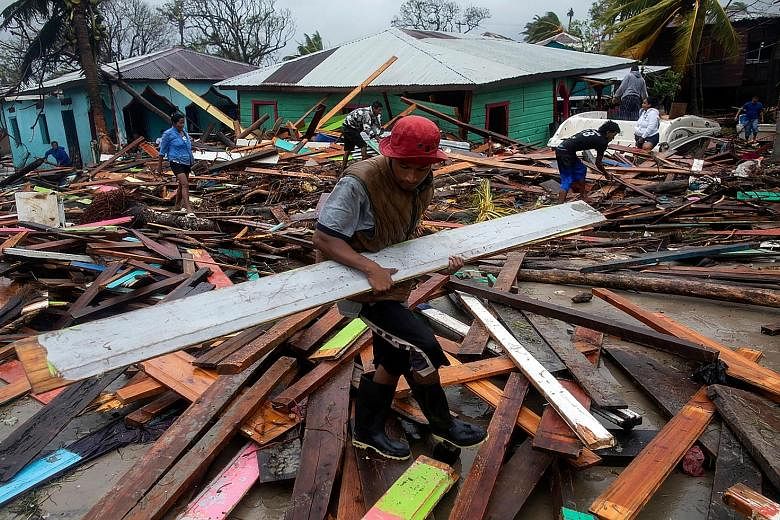PUERTO CABEZAS (Nicaragua) • Unleashing torrential floods even as it weakened, Storm Iota churned through Central America on Tuesday, causing swollen rivers to burst their banks, flipping roofs onto streets and killing at least nine people across the region.
The strongest storm on record to reach Nicaragua, Iota struck the coast late on Monday, bringing winds of nearly 250km per hour and flooding villages still reeling from the impact of Hurricane Eta two weeks ago.
But by Tuesday night, the winds had fallen to around 80kmh as Iota weakened to a tropical storm but heavy rainfall continued, the US National Hurricane Centre said.
Iota was drenching already saturated towns and villages as it moved inland over southern Honduras and as the authorities reported many people missing with some of the worst-hit areas still cut off.
"We're flooded everywhere, the rain lasted almost all night and now it stops for an hour then comes back for two to three hours," said Mr Marcelo Herrera, mayor of Wampusirpi, a municipality in the interior of north-east Honduras crossed by rivers and streams. "We need food and water for the population, because we lost our crops with Eta."
The Honduran government closed bridges and highways on Tuesday, while opening more than 600 shelters where some 13,000 residents sought refuge.
The double punch of Eta and Iota marked the first time two major hurricanes had formed in the Atlantic basin in November since records began.
The Nicaraguan port of Puerto Cabezas, still partly flooded and strewn with debris left by Eta, again bore the brunt of the hit.
Frightened residents were huddled in shelters on Tuesday.
"We could die. There is nothing to eat at all," said Ms Inocencia Smith at one of the shelters.
"The wind is too strong," said Ms Jessi Urbina, a resident of the badly damaged El Muelle neighbourhood in the Nicaraguan town of Bilwi. "It took everything: The wooden roof and the windows of my house, which is made of concrete."
Nicaraguan Vice-President Rosario Murillo said at least six people had died as they were dragged down by raging rivers.
The wind also tore the roof off a makeshift hospital. Patients in intensive care were evacuated, including two women who gave birth during the first rains on Monday, the Nicaraguan officials said.
Two people died on Providencia island, part of Colombia's Caribbean archipelago near the coast of Central America, after it was clipped by Iota, President Ivan Duque said on Tuesday evening.
Nearly all of the infrastructure on Providencia - home to some 6,000 people - had been damaged or destroyed.
Panama's government said a person had died in its western Ngabe-Bugle region because of conditions caused by the storm.
A resident of Brus Laguna on the Honduran coast told local radio that a boy was killed by a falling tree.
The International Federation of Red Cross and Red Crescent Societies (IFRC) said flooding from Iota risked causing disaster after Eta.
"We are very concerned about the potential for deadly landslides in these areas as the soil is already completely saturated," IFRC spokesman Matthew Cochrane said on Tuesday.
About 100,000 Nicaraguans and Hondurans had been evacuated from their homes, the authorities said.
Iota was some 56km south-east of the Honduran capital and was moving west at 19kmh where it could provoke "catastrophic flash flooding and mudslides", the National Hurricane Centre said, adding that Iota could dump up to 76cm of rain in some areas.
"We are in the hands of God. If I have to climb up trees, I'll do it," said Mr Jaime Cabal Cu, a farmer in Guatemala's Izabal province.
"We don't have food, but we are going to wait here for the hurricane that we're asking God to stop from coming."
REUTERS, AGENCE FRANCE-PRESSE

